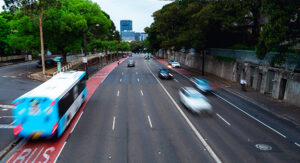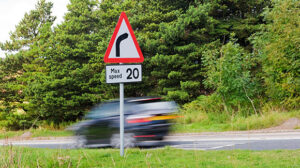Home » Driving Advice » How To Be A Confident Driver
How To Be A Confident Driver, Top Tips
Whether you have a fear of driving, have had a bad driving experience in the past or simply don’t have enough on-road experience, a lack of confidence behind the wheel can happen to anyone.
Many motorists feel anxious or worry about driving, especially if they have been involved in an accident. This may put you and other road users at risk.
Fortunately, there are several things you can do to reduce your driving anxiety and help you on your way to becoming a safer, more confident driver.

Prepare your vehicle
Before you set out on a journey, make sure your vehicle is safe and roadworthy. When your confidence has taken a hit, the last thing you need to be worrying about is whether your brakes will work or if your vehicle will get you to your destination.
- You should always keep your fuel tank at least a quarter full.
- Make sure your tyres meet the legal requirements. The legal minimum tread depth for car tyres is 1.6mm.
- Ensure all lights and the brakes are working.
- Check oil, brake, coolant and screenwash levels are correct.
- Make sure the vehicle’s windows and windscreen are clean inside and out and that there is no damage.
Practice makes perfect
The best way to improve your driving skills is through regular practice. This will make you a more confident driver as you’ll become more comfortable with your vehicle’s controls and how it feels to drive.
You’ll also develop your observational skills and build up your driving knowledge, so you will know what to do in certain situations.
You should be practising your driving skills on various types of roads, as well as in severe weather. This will ensure that you’re well prepared and can adapt your driving style to challenging conditions when required.
Many young drivers find night-time driving intimidating. This is mainly because they haven’t built up enough experience or confidence in night-time road conditions.
Driving at night requires a different skill set, such as spotting hazards and judging speed and distance. Practising your driving skills at night will help you to become a safer and more competent driver.
The process of becoming a more confident driver also involves recognising and acknowledging your weaknesses. If you’re struggling with roundabouts, driving manoeuvres, or motorway driving, it’s time to address your weaknesses by putting in extra practice in those areas.
Many motorists have a fear of motorway driving. But statistically, UK motorways are amongst the safest types of road to drive on, so you shouldn’t feel nervous or intimidated about driving on them. You can also see our tips and advice on motorway driving.
Likewise, if you’re struggling with driving manoeuvres, find an empty car park or a quiet industrial estate where you can put in some extra practice, without being put under pressure from other road users.
Attach ‘P’ plates to your vehicle
If you’re a new driver, you can display green (probationary) ‘P’ plates on your vehicle. This lets other road users know that you have recently passed your driving test.
There is no legal requirement to do so, but using ‘P’ plates may give you peace of mind as you build up your confidence and on-road experience. It will also encourage other road users to give you a little more leeway if you make mistakes on the road.
You can also leave ‘P’ plates on your vehicle for as long as you feel necessary.
Don’t allow other motorists to intimidate you
Many motorists will have some experience of being on the receiving end of road rage. If you’re the victim of road rage, keep calm and don’t react, as doing so could make the situation far worse.
If someone is tailgating you, drive slower, allowing them more space in front of you to pass. Do not change your driving style to suit them by speeding up, or hit the brakes to try and force them to slow down.
Acknowledge your mistakes. If you think you have done something wrong, then an apology may help to defuse the situation.
Use breathing techniques to help keep you calm
If you feel anxious while driving, controlling your breathing can help you keep calmer. Breathing exercises are a great way to reduce anxiety and stress.
Breathe in slowly through your nose, allowing your stomach to expand and then out slowly through your mouth. Repeat the exercise several times, until you feel calm.
Eliminate distractions
When driving, it’s important to maintain your concentration. Failing to do so puts you and other road users at risk of an accident. So you’ll need to eliminate any distractions that may affect your concentration.
If you’re short on confidence, you may feel more comfortable driving on your own, unless you’re accompanied by a responsible adult that can provide guidance and reassurance.
Younger passengers may cause a distraction as they have a tendency to encourage drivers to take more risks. The last thing you need is someone telling you to speed up or honk your horn when you’re behind the wheel.
It’s illegal to use a handheld phone while driving, so before you set off on your journey, put your phone somewhere out of sight, such as the glove compartment where it won’t cause a distraction.
Listening to music may help you to keep calm behind the wheel. But you’ll want to avoid your in-car music becoming a distraction. So, think carefully before you start adjusting the volume or changing radio channels as this can cause you to make mistakes that can affect your confidence.
De-clutter your vehicle so that it is free of loose items that may move around while you’re driving. Keep your vehicle clean and tidy.
Take refresher lessons
Refresher driving lessons are a great way to regain confidence if you feel anxious about driving or you’re a little rusty behind the wheel. Regardless of your age and experience, refresher lessons may help give you the confidence and skills you need to get you back on the road. They cover many aspects of driving and can be tailored to your needs.
So, if you have a fear of motorway driving, are not sure what to do at certain junctions, or want to get back on the road after an accident, refresher lessons can help.
Plan your route
Plan every journey especially when you’re building up your confidence. The last thing you want to do is leave everything to chance. You may end turning off at the wrong exit or end up on unfamiliar roads.
If you use a sat nav, make sure it is up to date and input your destination before setting off.
Choose routes that you are familiar with and that are less challenging. Start with shorter trips in quieter areas where you can improve your confidence and build up to busier routes.
Avoid driving during peak traffic hours or built-up areas where you may need to be extra vigilant around pedestrians, especially children.
Always allow plenty of time to complete your journey so that you’re not putting yourself under unnecessary pressure to make up time if you go off schedule.
Tiredness
Ensure you are well rested before making any journey. Driving while tired is dangerous and puts you more at risk of an accident. Tiredness makes you less attentive, reduces your reaction times, and affects your ability to make decisions.
You should avoid driving if you’re feeling tired. If you’re already on the road and start to feel sleepy, do not try to complete your journey. For longer journeys, take regular rest breaks at least every two hours.
Keep up to date with changes to The Highway Code
The Highway Code is updated regularly to reflect changes to UK driving laws and the rules of the road. Keeping up to date with the changes in The Highway Code will give you the knowledge and the skills you need so that you can get to and from your destination safely.
Commentary driving
Commentary driving involves describing everything that is going on around you as you’re driving. It’s an effective technique that helps you to maintain your focus and concentration.
Examples may include:
- The use of mirrors and indicators.
- Changes to the speed limits.
- Approaching hazards such as traffic lights and roundabouts.
- Anticipating what other road users might do next.
- Changes in the road conditions, such as the road narrowing or tight bends.
Take out a black box insurance policy
A black box insurance policy can not only save you money on your premiums, but it can also help you to become a safer, more confident driver.
When you take out a black box policy, a small device is fitted into your vehicle that monitors your driving performance. Real time data collected from the device allows you to monitor your driving behaviour and improve your driving style throughout the year.
It can also assist you in the event of an accident and contact the emergency services where necessary. So, you’ll have peace of mind knowing that help is at hand if you need it.
Final thoughts
The tips provided in this article will help you to become a more confident driver. Remember that everyone makes mistakes. If you make an error, don’t dwell on it. Instead, take a deep breath, relax, and focus on the road ahead.
Share this article
Table of Contents
More posts

What Happens If You Drive In A Bus Lane By Mistake?

What Happens If You Speed With A Black Box?

UK Speed Limits: Here’s What You Need To Know

